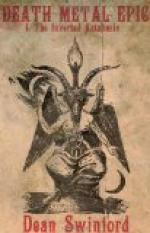The Celts all practised what is termed the Druidic cult, their priests being poets, bards, or gleemen, who could compose or recite in verse, ritual, laws, and heroic ballads. During the four hundred years of Roman occupation, the Celts in England became somewhat Romanized, but the Irish, and their near relatives the Scots, were less influenced by Latin civilization. It is therefore in Ireland, Scotland, and Wales that the oldest traces of Celtic literature are found, for the bards there retained their authority and acted as judges after Christianity had been introduced, and as late as the sixth century. Although St. Patrick is reported to have forbidden these Irish bards to continue their pagan incantations, they continued to exert some authority, and it is said Irish priests adopted the tonsure which was their distinctive badge. The bards, who could recite and compose poems and stories, accompanying themselves on a rudimentary harp, were considered of much higher rank than those who merely recited incantations. They transmitted poems, incantations, and laws, orally only, and no proof exists that the pagan Irish, for instance, committed any works to writing previous to the introduction of Christianity in their midst.
The heroic tales of Ireland from a large and well-marked epic cycle, the central tale of the series being the anonymous “Cattle of Cooly,” wherein is related the war waged by the Irish Queen Mab against her husband for the possession of a mystic brown bull. In the course of this war the chief hero, Cuchulaind, makes himself famous by defending the country of Ulster single-handed! The still extant tales of this epic cycle number about thirty, and give in detail the lives of hero and heroine from birth to death, besides introducing many legends from Celtic mythology. The oldest MS. version of these tales, in mingled prose and verse, dates back to the twelfth century, and is hence about as venerable as the Edda.
The Fennian or Oisianic poems and tales form another famous Irish cycle, Finn, or Fingal, their hero, having acted as commander for a body of mercenaries in the third century. His poet son, Oisin (the Ossian of later Romance), is said to have composed at least one of the poems in the famous Book of Leinster. Between the twelfth century and the middle of the fifteenth, this Fennian epos took on new life, and it continued to grow until the eighteenth century, when a new tale was added to the cycle.
The names of a few of the early Irish poets have been preserved in Irish annals, where we note, for instance, Bishop Fiance, author of a still extant metrical life of St. Patrick, and Dallan Frogaell, one of whose poems is in the “Book of the Dun Cow,” compiled before 1106. Up to the thirteenth century most of the poets and harpers used to include Scotland in their circuit, and one of them, Muiredhach, is said to have received the surname of “the Scotchman,” because he tarried so long in that country.




